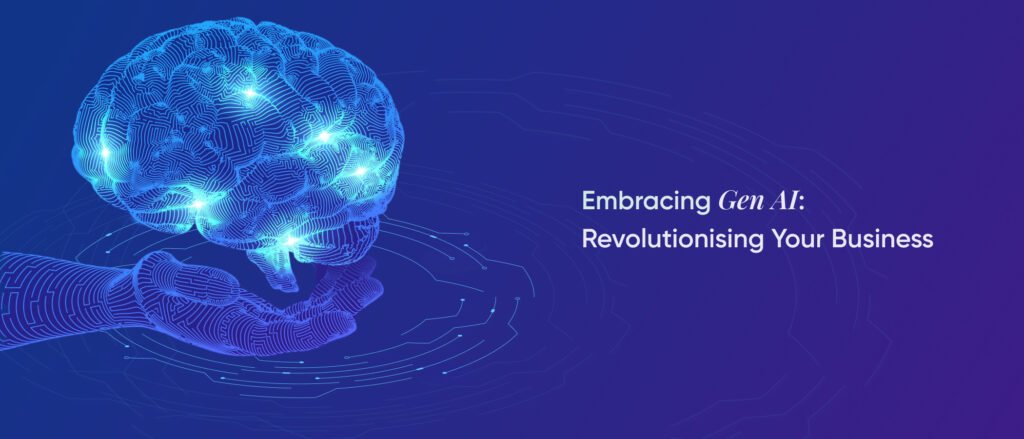In the ever-evolving fast-paced digital world, Generative AI emerges as a pivotal force, promising to redefine how businesses operate in the 21st century. This advanced form of artificial intelligence goes beyond traditional rule-based systems, harnessing the power of machine learning to create, innovate, and adapt autonomously. But what exactly is Gen AI, and why should your business care about it?
Understanding Gen AI
Generative AI (Gen AI) is a breakthrough in artificial intelligence, allowing machines to generate content, designs, and code that mimic human creativity. Unlike traditional AI, Gen AI learns from vast datasets to produce novel outputs. Models like OpenAI’s ChatGPT and DALL-E, as well as Google’s Gemini, use advanced algorithms for realistic results across various fields.
According to Forbes, generative AI is reshaping retail by offering personalized shopping experiences and improving business practices. AI styling, which provides tailored fashion recommendations, benefits both B2B and B2C. A 2024 Nvidia study found AI boosted revenue for 69% of retailers and cut operating costs by 72%. The retail AI market is expected to reach $85.07 billion by 2032, reflecting its growing influence.

What Are Some Types of Generative AI?
Generative AI uses neural networks and deep learning methods to produce the following models:
- Generative Pre-trained Transformers (GPTs): Designed for natural language processing (NLP) tasks, GPTs use transformer neural networks to learn context by identifying relationships between different elements in sequential data. They can generate coherent and relevant text based on the given prompt. They have a wide range of applications, ranging from content creation and chatbots to summarization and translation.
- Generative Adversarial Networks (GANs): GANs consist of two neural networks—the generator and the discriminator—that work together to create realistic images, videos, and audio. The generator produces new content for the discriminator to evaluate as real or fake, thus generating more realistic content that fools the discriminator over time. GANs also have a variety of applications, ranging from product design to art creation.
- Variational Autoencoders (VAEs): VAEs learn to generate new data by analyzing the underlying distribution of a dataset. They use probabilistic sampling techniques on compressed lower-dimensional data to create new data. They are widely used in applications requiring image synthesis, music composition, and anomaly detection.
Why Your Business Needs Gen AI

Gen AI is revolutionizing industries by unlocking creativity, improving efficiency, personalizing customer experiences, and offering data-driven insights.
- Fueling Innovation: Gen AI accelerates the creative process by generating fresh ideas, designs, and prototypes, saving time and inspiring new concepts in fields like marketing, design, and product development.
- Elevating Efficiency: By automating tasks like data entry and customer service, Gen AI boosts productivity and cuts operational costs, allowing teams to focus on critical initiatives.
- Personalizing Customer Experiences: Gen AI tailors content and recommendations based on real-time customer data, enhancing engagement, satisfaction, and loyalty.
- Data-Driven Insights: Gen AI quickly processes large datasets, providing actionable insights and predictive analytics to optimize decision-making and mitigate risks.
- Adapting to Change: With its ability to learn and adapt, Gen AI helps businesses stay agile, seize opportunities, and navigate challenges effectively.
Embrace the Future with Gen AI
To wrap things up, Generative AI represents more than just a technological advancement; it is a strategic asset for businesses aiming to thrive in the digital age. By integrating Gen AI into your business strategy, you can unlock untapped potential, drive innovation, and deliver exceptional value to your customers. Embrace Gen AI today and transform your business for tomorrow.
Ready to harness the transformative power of Generative AI for your business? Contact us to explore how Gen AI can revolutionize your operations, enhance customer engagement, and propel your growth journey in the digital era.
*Content produced for educational & informational purposes only.
Content authored by Kashvi Dikshit
Frequently Asked Questions
Generative AI creates new content, such as images, text, and designs, based on vast datasets, unlike conventional AI, which follows pre-defined rules and uses existing data for analysis.
Yes, Gen AI tailors content, offers personalized recommendations and improves customer engagement by analyzing real-time data to provide targeted experiences.
Hutech Solutions offers tailored Gen AI systems designed to enhance efficiency, customer engagement, and innovation. Our experts guide you through the process, ensuring seamless integration into your existing operations.
The fees depend on the complexity of the solution, the scale of implementation, and ongoing maintenance. However, the long-term gains in efficiency and innovation often outweigh the initial investment.
Ready to Advance your Digital Transformation?Get in touch with us.
Discover why Hutech is the right partner for your business.
MAIL US AT
sales@hutechsolutions.com
CONTACT NUMBER
+91 90351 80487
CHAT VIA WHATSAPP
+91 90351 80487
Humantech Solutions India Pvt. Ltd 163, 1st Floor, 9th Main Rd, Sector 6, HSR Layout, Bengaluru, Karnataka 560102




